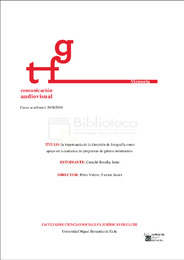Por favor, use este identificador para citar o enlazar este ítem:
https://hdl.handle.net/11000/7502Registro completo de metadatos
| Campo DC | Valor | Lengua/Idioma |
|---|---|---|
| dc.contributor.advisor | Pérez Valero, Vicente Javier | - |
| dc.contributor.author | Castelló Botella, Irene | - |
| dc.contributor.other | Departamentos de la UMH::Ciencias Sociales y Humanas | es |
| dc.date.accessioned | 2021-04-26T18:01:56Z | - |
| dc.date.available | 2021-04-26T18:01:56Z | - |
| dc.date.created | 2019-09-11 | - |
| dc.date.issued | 2021-04-26 | - |
| dc.identifier.uri | http://hdl.handle.net/11000/7502 | - |
| dc.description.abstract | La dirección de fotografía, en los últimos años, ha aumentado su repercusión en las producciones audiovisuales. Esto ha llevado a que programas de televisión de índole informativo introduzcan esta disciplina típica del cine y del documental. Salvados, es un ejemplo, por ser un programa de reportajes periodísticos que cuenta con la figura del director de fotografía. Por ello, este trabajo Final de Grado tiene como propósito demostrar que este programa aúna las características del género documental y del reportaje periodístico. En consecuencia, el trabajo se centra en estudiar las diferencias estéticas entre el documental y el reportaje, buscar programas anteriores a Salvados y analizar la dirección de fotografía de éste para mostrar la importancia y la novedad de su propuesta estética en el reportaje periodístico. Para el estudio, el método a seguir ha sido la revisión bibliográfica y el análisis de las temporadas 12, 13 y 14 del programa Salvados. | es |
| dc.description.abstract | The direction of photography, in recent years, has increased its impact on audiovisual productions. This has led to informative television programs introducing this typical discipline of cinema and documentary. Salvados, is an example of journalistic reports program which presents the director of photography as member of the staff team. Hence, this Project aims to demonstrate that this program combines the characteristics of the documentary genre and the journalistic report. Consequently, the work focuses on studying the aesthetic differences between the documentary and the report, looking for programs prior to Salvados and analyzing the photography direction of the latter to show the importance and novelty of its aesthetic proposal in the journalistic report. For the study, the method to follow has been the bibliographic review and analysis of seasons 12, 13 and 14 of the Salvados program. | es |
| dc.format | application/pdf | es |
| dc.format.extent | 159 | es |
| dc.language.iso | spa | es |
| dc.publisher | Universidad Miguel Hernández de Elche | es |
| dc.rights | info:eu-repo/semantics/openAccess | es |
| dc.subject | Salvados | es |
| dc.subject | cinematography | es |
| dc.subject | dirección de fotografía | es |
| dc.subject | documental | es |
| dc.subject | reportaje | es |
| dc.subject | televisión | es |
| dc.subject | estética | es |
| dc.subject | documentary | es |
| dc.subject | reportage | es |
| dc.subject | television | es |
| dc.subject | aesthetic | es |
| dc.subject.other | CDU:3 - Ciencias sociales:316 - Sociología. Comunicación | es |
| dc.title | La importancia de la dirección de fotografía como apoyo en la narrativa de programas de género informativo | es |
| dc.type | info:eu-repo/semantics/bachelorThesis | es |
| dc.type | info:eu-repo/semantics/bachelorThesis | es |
| dc.type | info:eu-repo/semantics/bachelorThesis | es |

Ver/Abrir:
TFG-Castelló Botella, Irene.pdf
3,88 MB
Adobe PDF
Compartir:
 La licencia se describe como: Atribución-NonComercial-NoDerivada 4.0 Internacional.
La licencia se describe como: Atribución-NonComercial-NoDerivada 4.0 Internacional.
.png)